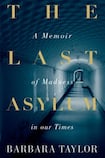
Perplexity rings us in and out of Barbara Taylor's memoir, The Last Asylum: A Memoir of Madness in Our Times . The memoir splices together the recent history of Britain's last asylum and Taylor's eight-month "version of her history" in it.
In 1981 Taylor, a distinguished historian who “knew little kindness” in her early years and had been perpetually unhappy, broke down and commenced analysis. Six years later she voluntarily admitted herself to Friern Hospital, a psychiatric institution on the northern edge of London. In total she had three stays.
The shift from the old asylum system to the current community model is charted in the book, which also explores the “opposition between psychological and biomedical models of madness” and how this conflict has been reconfigured by the demise of the asylum.
Middlesex County Pauper Lunatic Asylum, as Friern Hospital was originally known, was one of Britain’s largest and more progressive mental hospitals. It eventually closed in 1993. Place a historian in that setting as a patient and you have metahistory: a personal history, where the historian finds herself the source material. The historian’s history layered within the history of the historical space and the history that led her to both occupy and exit it.
Play that forward to include present-day gentrification and the hospital has transformed itself into luxury condominiums. That real estate has conquered psychiatry is hardly surprising, given that it already had us by the balls and has chopped up our spleens.
Usually a hybrid approach can enrich a book's subject, but in The Last Asylum it has a diluting effect. Readers are in the hands of an excellent historian, but when the self-indulgent memoirist crosses the central meridian to interrupt, it's a struggle not to regularly find her a pain in the neck. We are drowned by the shouty Harley Street confessional. Taylor is upfront and aware of this, documenting her worst behaviour, robustly transparent about her manipulations and narcissism.
Anyone with immense patience for italics, or an active interest or paid practice in psychoanalysis, will find Taylor’s testimony of her psychoanalysis scintillating, but for the plain reader either on anti-depressants or acquainted with a more acute, utilitarian, ongoing edition of mental illness in friends or family this marshalled and ultimately privileged version can seem alien.
Taylor just doesn’t seem very mad. Her symptoms amounted to terrible violent dreams, acute loneliness, sodden drinking, excessive pills (in other words a pretty average Thursday) and escalating neurosis mostly brewed up in or by psychoanalysis.
Even the economy of Taylor’s access to treatment is substantially different from that of the average punter cracking up at the bus station: she commutes to psychoanalysis five days a week, even while in Friern, giving her the services of two therapists.
Many contradictions
She admits her many contradictions. She bullies her friends, insisting they rally around her, while the reader, to be honest, is unsure how they didn't take a spade to her. She abuses her psychoanalyst, but he's paid to release her lunatic psyche and gives plenty back by return serve. In 1990 her analysis affords her a transformative experience, which appears to prove amen to her "madness" and "career as a mental patient".
It’s important to note that her “madness years” contained themselves to a decade. Is it that Taylor’s is a history we haven’t heard before? If so, what will this book do to lessen the stigma of mental illness? Not so much. It’s the version and outcome of mental illness we want to believe exist for all – and put simply, they don’t. What strongly augments this quandary in the work is Taylor’s contextualising of the history of Friern Hospital, the end of the asylum era, the pendulum-swinging approach to mental-health treatment. She points up what we may not realise has been lost.
Taylor grew up in Saskatoon, on the Canadian prairies; her parents were communists, making her a red-diaper baby. Her father was a lawyer, her mother a magistrate and then, latterly, a judge. Taylor revered her parents, prominent leftie activists, and she, in turn, was regarded as their “beautiful, clever daughter”. Except she had toppling tension with both of them, including bonfire-high rows with her father.
Filial duty
She internalised a desperate need to please and conform to the ideals and demands they transmitted to her. One of these demands concerned literature: "I was born to write, to conjure words that the world would applaud; literary renown was my filial duty."
And write she did, several successful, highly acclaimed books: a feminist history book and a children’s book. She also took on her first academic teaching job before she began to experience mental fragility, struggled to function, and began her 4,000 sessions of psychoanalysis.
Her parents’ carry-on was complicated: Dad was something of a raging bully, revolutionary hero and philanderer; Mum was more inclined to accept her lot, idealise Dad and prop him up. Both parents had a holy terror of being ordinary and passed this along to their daughter, accompanied by the deluded idea that salvation would be possible only if she wrote books. In other words, attained status on their terms.
Throughout her life Taylor carried a debilitating parental anxiety. So while her parents were busy doing everything possible to avoid being ordinary, she was worried about ordinarily being their daughter. The “ordinary”, bizarrely, became the family enemy. In something of an irony, it was in the asylum that Taylor, the most ordinary patient, puzzled out and created a family dynamic with some of the other patients.
That a book about a conflicted subject may give rise to a conflicted reading does not necessarily diminish its value. The reader exits perplexed but imbued with historical knowledge and the impetus to further contemplate the shifts in mental-health treatment.












